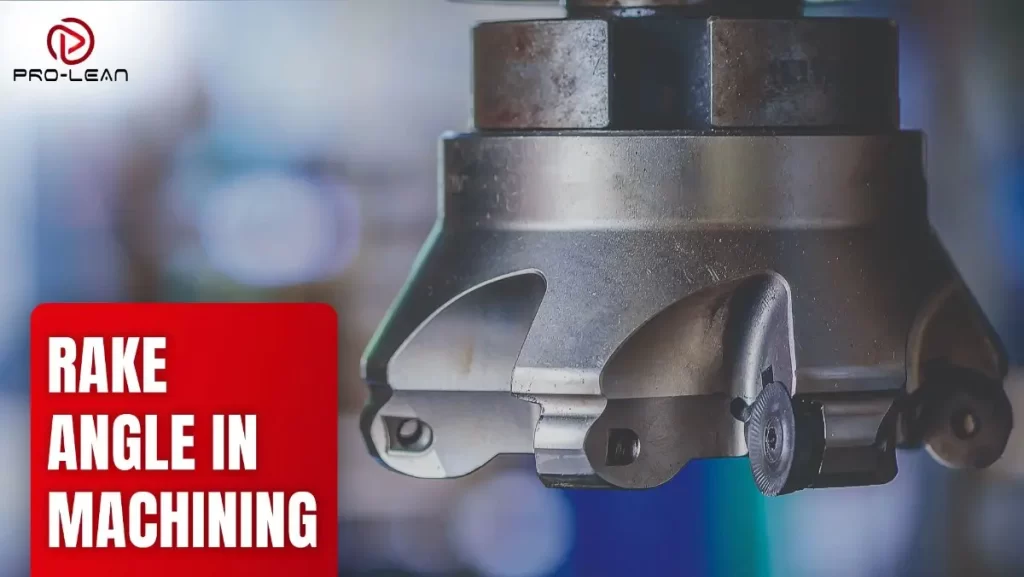
Rake Angle in Machining
The rake angle is a key part of a cutting tool in machining. It’s the angle between the cutting edge and the material you’re cutting.
This angle changes how the tool cuts, how strong the edge is, and how the chips come off. Whether you’re cutting metal or plastic, choosing the right rake angle makes a big difference in the cutting process.
At ProleanTech, we use the best rake angles so you get cleaner cuts, tools that last longer, and super smooth finishes on everything we machine.
This article will explain what rake angle means, the types, as well as angle cut guide, benefits, and help you choose the right one for different machining cutting jobs. Let’s get started!
Learn more in our CNC Machining Complete Guide.
What is the Rake Angle?
The rake angle is the angle between the top of the cutting tool and a straight line that is straight up (90 degrees) from the material being cut. It changes how the equipment slices into the material and how metal chips come off.
The correct rake angle cuts with low force, produces less heat, and makes a smoother finish. Positive rake angles cut easier with low power, while negative rake angles are stronger and better for cutting hard materials.
The rake angle can be different for the tool and material you’re cutting.
What is the Function of Rake Angle?
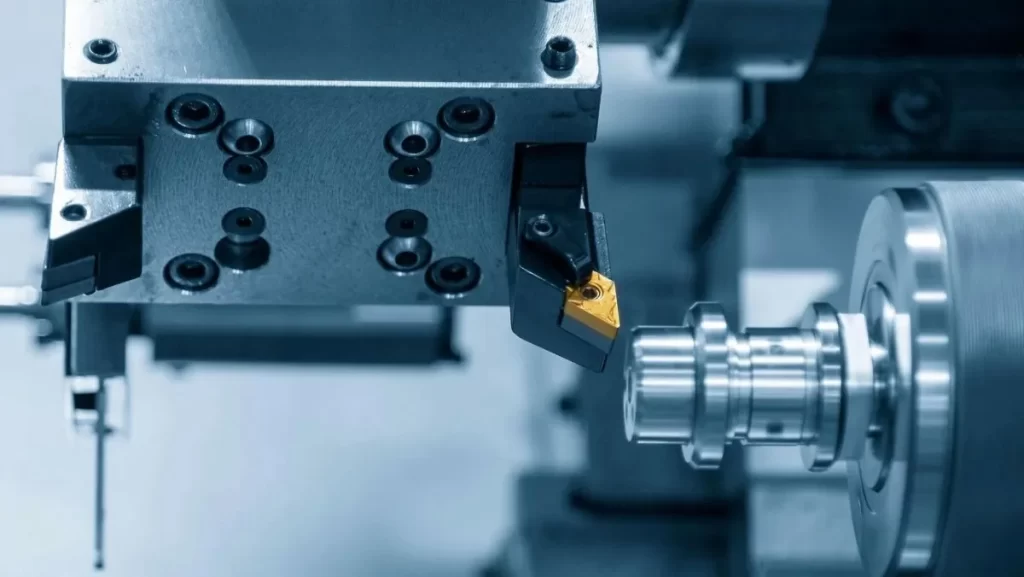
Function of Rake Angle
The rake angle plays a big role in how a cutting tool does its job. It controls how the metal chip breaks and moves away while cutting.
A positive rake angle is good for cutting soft stuff such as aluminum. This makes chips easier, and you do not need that force. It also means low heat and long equipment life.
For hard or brittle material, a negative rake angle is often better. It makes the cutting edge stronger and less likely to break the tool.
The rake angle also affects how the heat goes away and how much the machine shakes during cutting.
Why Rake Angle Matters in Machining?
Rake angle isn’t just a small part of the tool – it makes a big difference in how machining cutting works. Choosing the right rake angle makes your job easier, faster, and better.
1. Less Power Needed
Think of using a sharp knife versus a dull one. A sharp knife cuts more easily. Just like that, a tool with a good rake angle cuts metal. This means your machine uses less power and energy and lasts longer.
2. Better Heat Control
Cutting metal generates a lot of heat. Too much heat can damage the tool and the metal piece. Rake angle helps control this heat. A good rake angle reduces heat and sends it away with the metal chips, keeping things cooler.
3. Smoother Surface Finish
Everyone wants a neat and smooth finish on the part. Rake angle helps the tool cut clean, which gives a smoother surface. Bad rake angles can give rough or uneven finishes.
4. Longer Tool Life
Cutting tools cost money. If they wear out fast, you lose money and time. A proper rake angle reduces the pressure on the tool and doesn’t wear it down quickly. This makes the tool last longer.
Tool Angles for Cutting: Rake vs Relief vs Clearance Angle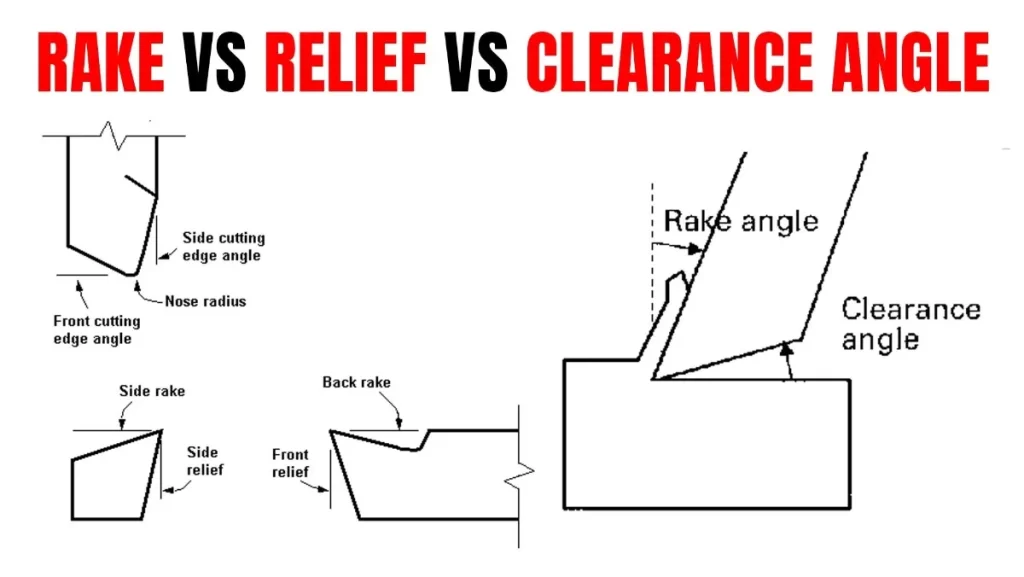
Rake vs Relief vs Clearance Angle
Cutting tools have special angles that make them work smoothly and accurately. Each angle has a role:
- Rake Angle helps chips move away from the tool and reduces cutting force.
- Relief Angle stops the tool from rubbing against the workpiece.
- Clearance Angle keeps space between the tool and the finished surface to avoid damage.
When these angles are wrong, the tool will wear out fast or cut badly. That’s why at ProleanTech, we always follow a cutting angle guide to match the tool shape with each client’s job.
| Angle Type | Purpose |
| Rake Angle | Directs chip flow; lowers cutting force |
| Relief Angle | Avoids rubbing against the material |
| Clearance Angle | Keeps the tool off the surface after cutting |
Try Prolean Now!
Types of Rake Angles Used in Angle Cut
Different jobs require different rake angles to get the best results. The rake angle you choose changes tool strength, chip flow, and how it cuts. Below are the three main types of rake angles:
1. Positive Rake Angle
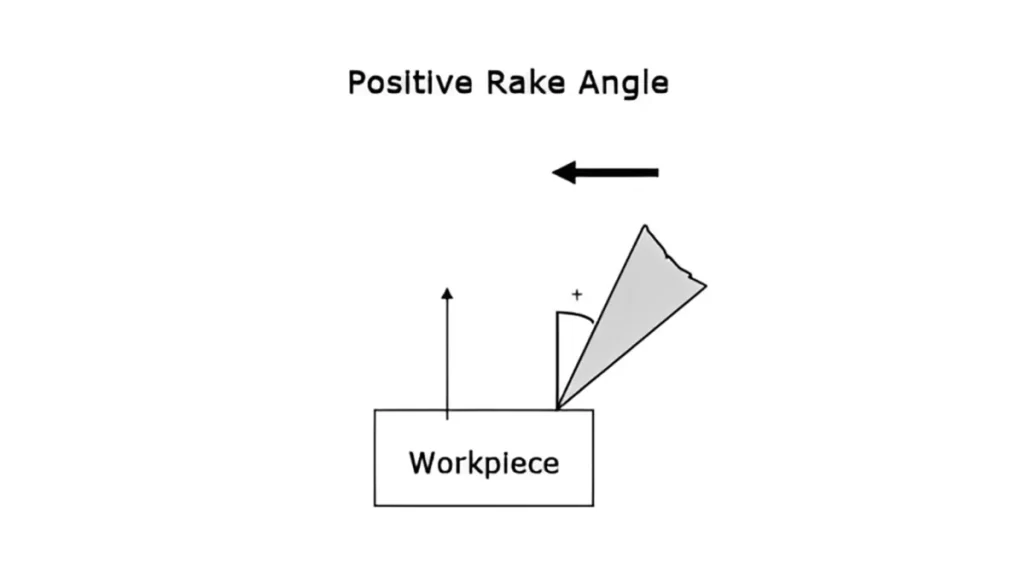
Positive Rake Angle
A positive rake angle means the tool face is away from the cutting edge. This is used for cutting soft materials like aluminum, plastic, and copper. It makes cutting easier and chips flow smoothly.
It also gives a better surface and less heat. But the cutting edge is weaker and might break. Not good for hard or rough materials. Use this when you need smooth cuts, faster machining, and less machine power.
Pros:
- Less force needed
- Good surface finish
- Less heat during cutting
Cons:
- The tool edge is weaker
- Not good for hard materials
2. Negative Rake Angle (Negative Rake Lathe Tool)
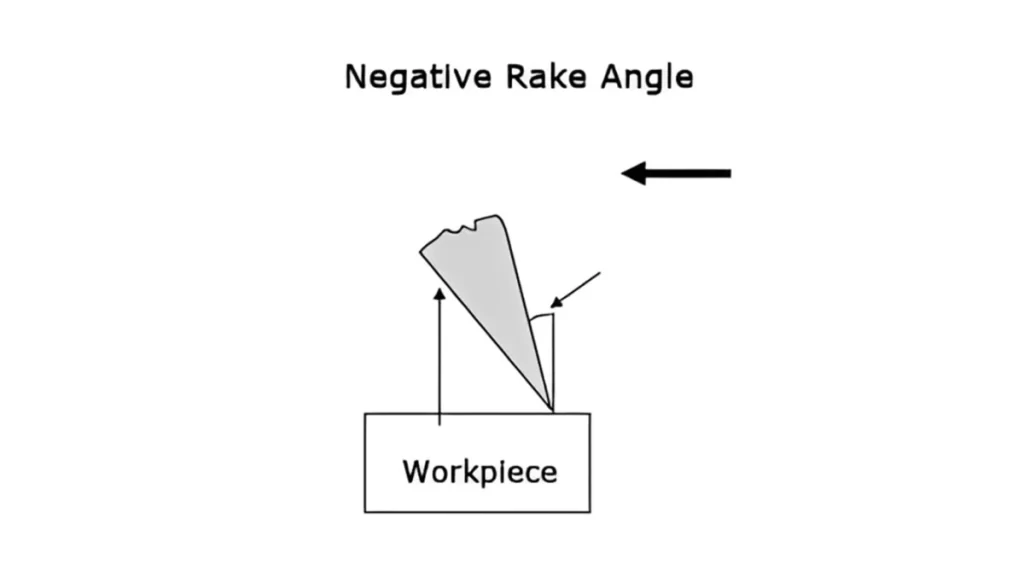
Negative Rake Angle
A negative rake angle means the tool face is towards the cutting edge. This makes the cutting edge stronger and thicker. This is good for cutting hard materials like cast iron and tool steel. It’s good in high heat or heavy load jobs.
The tool lasts longer and won’t chip. But needs more cutting force and might give more heat. It can also give a rougher surface on soft materials. Use this for tough jobs where tool strength is more important than finish.
Pros:
- Strong cutting edge
- Good for hard metals
- Good for heavy-duty machining
Cons:
- Needs more power
- May give more heat
- Can give a rougher surface
3. Neutral Rake Angle (Zero Rake Angle)
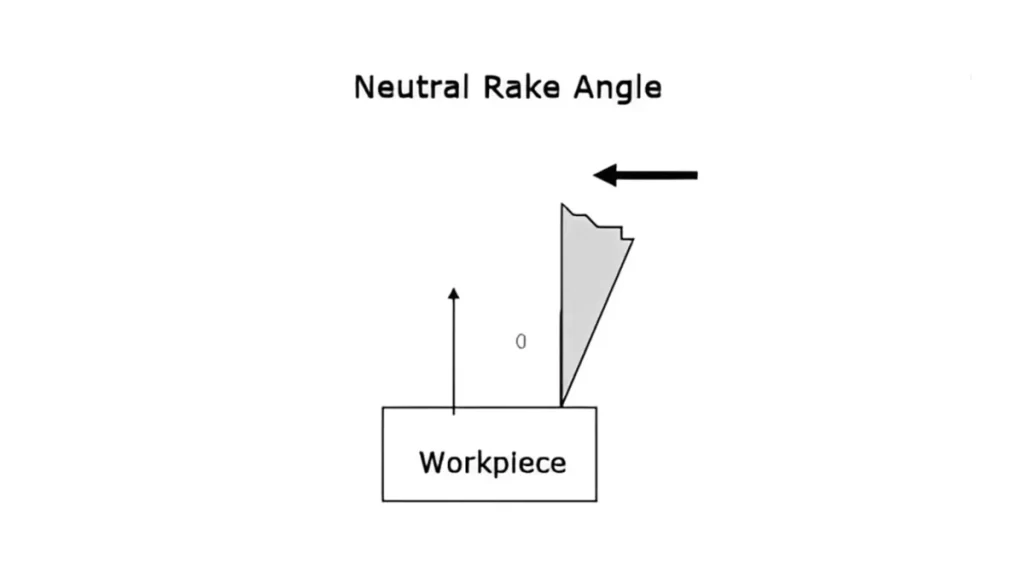
Neutral Rake Angle
A zero rake angle means the tool face is flat—neither leaning forward nor backward. It’s balanced strength and sharpness. This rake is good for general cutting jobs. Easy to sharpen and maintain.
Works okay with many materials, but not great with very soft or hard ones. Chips won’t break easily, and heat will build up faster. Still, it’s good for jobs with mixed materials or when you want simple and cheap tools. A good choice for average cutting tasks.
Pros:
- Balanced cutting
- Easy to sharpen
- Good for mixed materials
Cons:
- Not good for soft materials
- Chips won’t break
- Rougher surface
Check out our guide on https://proleantech.com/automotive-steel-and-usage/
Rake Angle – Quick Comparison Table
| Feature / Type | Positive Rake Angle | Negative Rake Angle | Neutral (Zero) Rake Angle |
| Chip Flow | Smooth and fast | Thicker, sometimes breaks | Moderate, may form long chips |
| Cutting Force | Low | High | Medium |
| Tool Strength | Lower edge strength | Very strong edge | Medium strength |
| Surface Finish | Very clean finish | Rougher finish on soft metals | Moderate finish |
| Heat Generation | Less heat | More heat | Average heat |
| Best For | Soft materials (e.g., aluminum) | Hard or brittle materials (e.g., steel) | Mixed or unknown materials |
| Power Requirement | Low | High | Moderate |
| Tool Life | Medium to short | Long | Moderate |
| Ease of Sharpening | Needs skill | Harder due to a strong edge | Very easy |
Rake Angle and Chip Formation in Metal Cutting
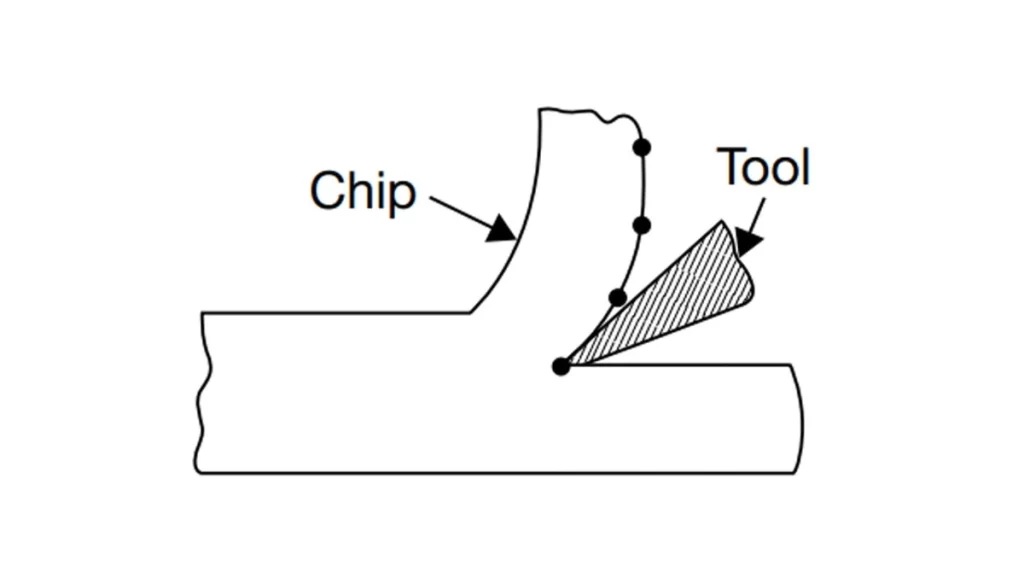
Rake Angle and Chip Formation
The rake angle has a big impact on the chips that are formed during cutting. Chips are the small pieces that come off when a tool removes material from a workpiece. The shape, size, and direction of these chips matter in machining.
A positive rake angle makes thin chips that curl smoothly and produces less heat. This is good for cutting soft materials. A negative rake angle makes a thicker and tighter curled chip, which requires more cutting force.
But this can also make the cutting edge stronger, especially for harder metals. If chips don’t come off well, they can damage the tool or the part. That’s why at ProleanTech, we make sure the rake angle is right to protect both tool and material.
Try Prolean Now!
Rake Angle Recommendations for Different Materials
Every material acts differently when cut. So the rake angle should match the material you are machining. This will give you smoother cuts and prevent the tool from getting damaged.
Soft materials like aluminum need a more positive rake angle. Hard materials like titanium or steel work better with negative rake. Brass, being in the middle, often uses a neutral rake angle. The chart below gives you a simple guide:
| Material Type | Recommended Rake Angle |
| Aluminum | 10° to 20° (Positive) |
| Steel | 0° to -10° (Negative) |
| Titanium | -5° to -10° (Negative) |
| Brass | 0° (Neutral) |
Machining Operations and Their Ideal Rake Angles
Each operation uses different tools. So, the best rake angle also changes per operation. Choosing the right angle makes things more efficient and tools last longer.
In turning, tools need negative rake angles. This gives more strength for continuous cuts.
In milling, a positive rake angle helps chip flow and reduces cutting force.
Drilling uses angles from neutral to slightly positive, depending on material and hole size.
At ProleanTech, we plan tool paths using the best angle for each operation to reduce tool wear and get better results.
Read more in our guide on Types of CNC Machines.
What Machines and Tools Are Used for Cutting Angles with Proper Rake?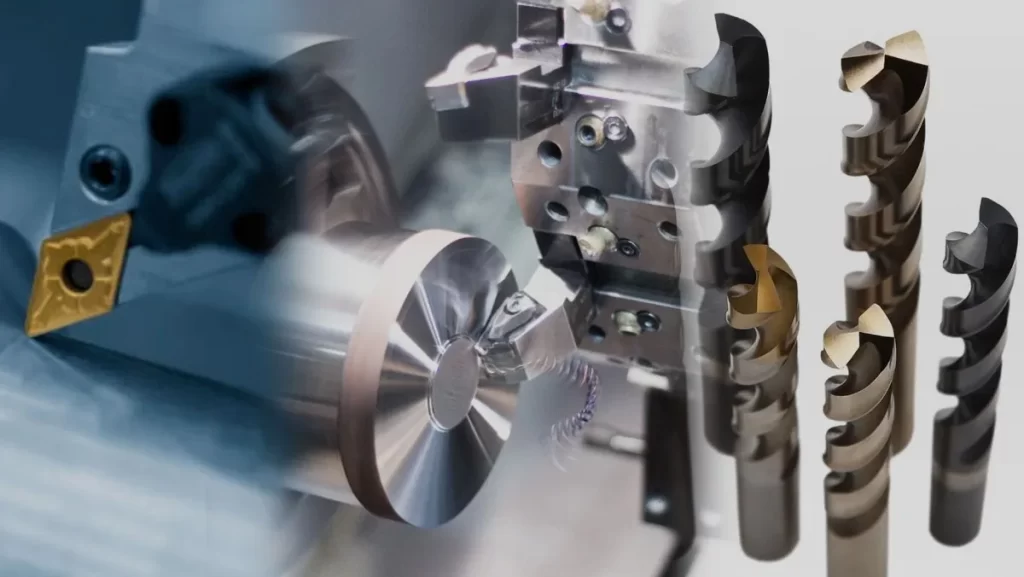
Rake Angle Tools
We set rake angles very precisely with modern machines. This gives us a better finish on parts and makes our tools last longer. The main machines we use for this are CNC lathes, CNC mills, and surface grinders.
These machines work with different cutting angles tools like:
- Carbide inserts: They are very strong and don’t wear out easily.
- High-Speed Steel (HSS) tools: They are more affordable and simpler to sharpen.
- Indexable tools: You can swap out their tips instead of replacing the whole tool.
At ProleanTech, we choose the right tool and machine based on the material, the job size, and what kind of cut is needed. This makes everything run smoothly.
Key Parameters That Define Rake Angle Performance
The rake angle changes many things while cutting. Choosing the right angle improves parts and saves both energy and money.
The most important things here are rake angle affects:
- Tool Wear Rate: If the rake angle is too high, the tool will quickly come out.
- Surface Finish: The correct rake angle gives a cleaner and smoother surface.
- Heat Generation: A wrong rake angle creates too much heat.
- Power Uses: A bad rake angle causes machines to use more energy than required.
This is why we always check the rake angle before making anything.
Factors That Influence Rake Angle Selection
Not every job needs the same rake angle. Many things help us decide which rake angle is best. These are:
- Material Toughness: Soft metals require a positive rake. Hard metals require a negative one.
- Cutting Speed: A Special rake design may be required for rapid cutting.
- Tool Material: Tools made of carbide can handle over stress, so they can use more negative rake angles.
- Power Consumption: Positive rakes reduce the required cutting force and protect the energy.
Common Mistakes in Selecting Rake Angles
Choosing an incorrect rake angle can lead to bad results. Here are some common mistakes that people make:
- Using a positive rake for rigid metals, which makes the cutting edge weak.
- Not thinking about how strong and stable the machine is.
- The rake does not match the angle of how fast you feed the material or the cutting speed.
These mistakes can cause damage to a bad surface, broken equipment, and even a machine. At ProleanTech, we avoid these by checking your design and offering the best angle setup before production. Contact with our experts for help avoiding these pitfalls.
Can Rake Angle Be Customized in Modern Cutting Tools?
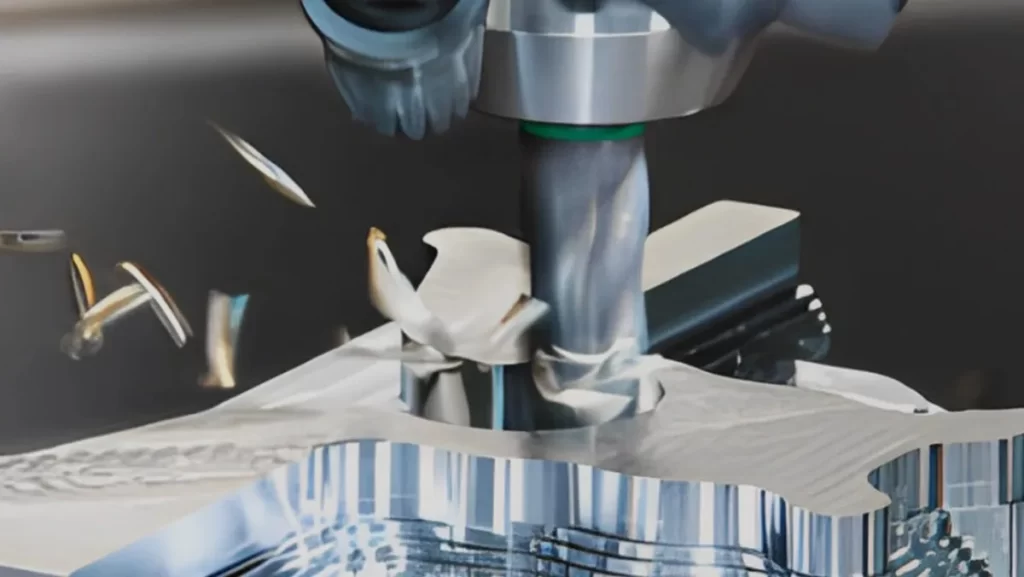
Rake Angle Customization
Yes. In today’s machining, rake angles can be made unique for every job. We do this by sharpening the tool or using special inserts. For fast cutting or working with special materials, custom rake angles help control the size and direction of the chips.
If the wrong angle is used, it can cause:
- A poor surface finish
- Tools wear out too quickly
- Vibration during cutting
That’s why our DFM (Design for Manufacturability) team at ProleanTech works closely with customers. We help them choose or change the right rake angle from the start.
Conclusion
The rake angle is super important in metal cutting. It affects how chips form, how much heat is made, how smooth the surface is, and even how much energy is used.
Positive rake angles are good for cutting soft materials like aluminum easily. Negative rake angles are better for hard materials like steel or titanium. Each machining job—like turning, milling, or drilling—needs a different rake angle.
CNC machines and cutting tools must be picked carefully to match the correct rake angle. Also, checking and adjusting the angle often keeps the tool working well and safely.
At ProleanTech, we focus on every detail of the rake angle—from choosing the tool to removing chips. This gives you a smooth finish, tools that last longer, and more efficient production.
Explore our CNC Machining Services or request a Custom Pricing Estimate to optimize your next machining project.
FAQs
- What does the rake angle measure?
It measures the tilt of the face of the cutting tool. This tilt affects how the tool is cut and how material chips are removed.
- What is positive and negative rake angle?
A positive rake angle means that the tool’s face is far from the cut, which makes it sharp. A negative rake angle means that it bends towards the cut, which strengthens the edge.
- How does rake angle affect handling?
The rake angle changes how easily the equipment cuts and how much force is required. A good angle makes the smooth cut and handle.
- What happens if the rake angle increases?
If the rake angle increases (becomes more positive), the tool cuts more easily with less force. However, the cutting edge also becomes weaker and can break more easily.

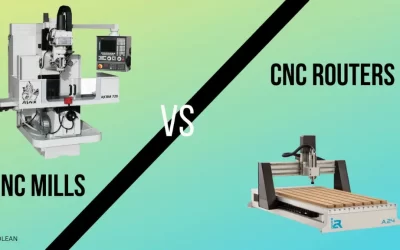
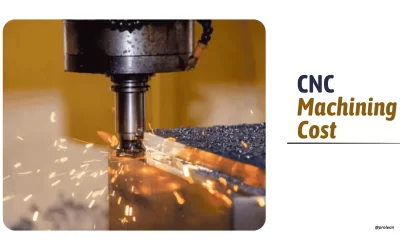
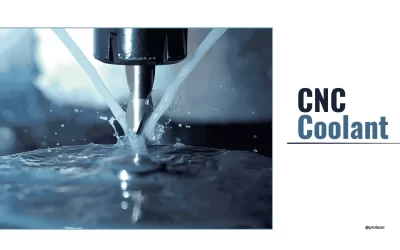
0 Comments